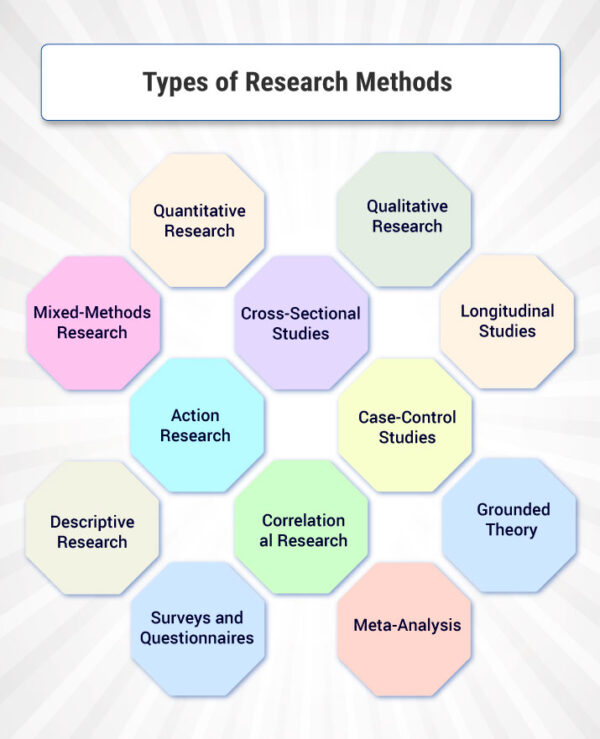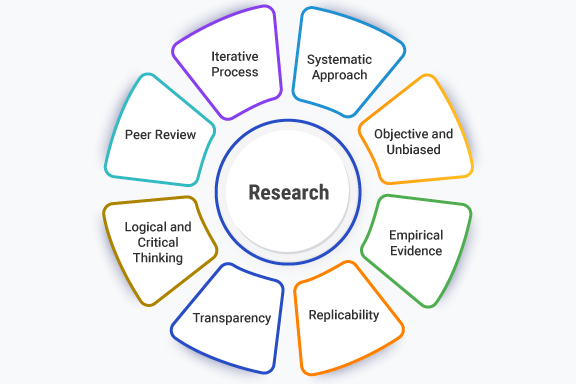What is Research?
Research is a systematic and methodical process of inquiry aimed at exploring, analyzing, and interpreting information to answer specific questions or solve problems. By following established research methodologies, investigators collect reliable data, draw meaningful conclusions, and contribute to the existing body of knowledge. In essence, research definition emphasizes structured inquiry, objectivity, and evidence-based understanding.
Key Characteristics of Research
- Systematic Approach: Research follows organized steps to ensure logical data collection, analysis, and interpretation.
- Objective and Unbiased: Conclusions are drawn based on evidence rather than personal opinions.
- Empirical Evidence: Observations, experiments, and surveys provide the foundation for findings.
- Clear Research Question: Every study begins with a specific problem or question guiding the process.
- Replicability: Others should be able to reproduce the study and achieve similar results.
- Transparency and Ethics: Researchers adhere to ethical standards, ensuring informed consent and confidentiality.
- Generalizability: Findings aim to apply beyond the studied sample or context.
- Logical and Critical Thinking: Data is analyzed carefully to identify patterns and insights.
- Contribution to Knowledge: Research advances understanding, challenges theories, or proposes new ideas.
- Peer Review and Publication: Findings are validated through expert review and shared in journals or conferences.
- Iterative Process: Research often leads to new questions and further studies.
- Practical Application: Results may inform policy, improve practices, or solve real-world problems.
Types of Research Methods

Research serves as a cornerstone for knowledge discovery, innovation, and decision-making. Understanding the various types of research methods is crucial for selecting the most appropriate approach to answer your research questions effectively. This guide delves into the major research methods, their applications, and tips on choosing the best one for your study.
1. Quantitative Research: Unlocking the Power of Numbers
Quantitative research is centered around collecting numerical data and employing statistical techniques to draw conclusions. This type of research is often used to measure variables, identify patterns, and establish causal relationships.
- Surveys:
-
- Purpose: Surveys are utilized to collect data from a large audience to identify trends and generalize findings.
-
- Method: Employ structured questionnaires with closed-ended questions.
-
- Example: Businesses conduct customer satisfaction surveys to understand consumer preferences and make informed decisions.
- Experiments:
-
- Purpose: Experiments are designed to test hypotheses by manipulating variables in a controlled setting.
-
- Method: Use experimental and control groups to establish cause-and-effect relationships.
-
- Example: In scientific research, experiments are conducted to evaluate the effectiveness of a new drug treatment.
- Observational Studies:
-
- Purpose: Observational studies involve watching and recording subjects without interference, providing insights into natural behaviors.
-
- Method: Systematically observe and document phenomena.
-
- Example: Wildlife researchers use observational studies to study animal behaviors in their natural habitats.
- Secondary Data Analysis:
-
- Purpose: Re-analyze existing datasets to extract new insights, saving time and resources.
-
- Method: Utilize pre-existing data from sources such as government databases or academic publications.
-
- Example: Economists analyze census data to examine employment trends and economic growth.
2. Qualitative Research: Exploring the Depths of Human Experience
Qualitative research focuses on understanding the intricacies of human experiences, beliefs, and social phenomena. It provides rich, in-depth insights and interpretations that numbers alone cannot capture.
- Interviews:
-
- Purpose: Conduct in-depth interviews to explore individual perspectives and gain insights into complex topics.
-
- Method: Use semi-structured or unstructured interviews to allow participants to share their thoughts freely.
-
- Example: Healthcare researchers interview patients to understand their experiences and emotional responses to treatments.
- Focus Groups:
- Purpose: Gather diverse opinions and insights from group discussions on specific topics.
-
- Method: Facilitate guided conversations with selected participants.
-
- Example: Marketing teams conduct focus groups to test new product concepts and gather feedback.
- Ethnography:
-
- Purpose: Immerse in a culture or community to understand their practices, values, and social dynamics.
-
- Method: Engage in long-term observation and interaction within the community.
-
- Example: Anthropologists conduct ethnographic research to study cultural rituals and traditions.
- Case Studies:
-
- Purpose: Provide an in-depth examination of a single subject, event, or organization to uncover insights and identify patterns.
-
- Method: Use multiple data sources to gain comprehensive knowledge.
-
- Example: Business analysts study successful startups to identify strategies for growth and innovation.
3. Mixed-Methods Research: Bridging the Gap
Mixed-methods research combines qualitative and quantitative approaches to gain a deeper insight into complex problems. This integration allows researchers to benefit from both numerical data and narrative insights.
- Purpose: Leverage the strengths of both quantitative and qualitative data.
- Method: Employ a combination of surveys, interviews, and other techniques.
- Example: Educational researchers use mixed methods to evaluate student performance through test scores and personal interviews.
4. Cross-Sectional Studies: Snapshot of a Moment
Cross-sectional studies analyze data from a population at a specific point in time to identify patterns, correlations, or differences between variables.
- Purpose: Provide a snapshot of a population’s characteristics and relationships.
- Method: Collect data simultaneously from multiple subjects.
- Example: Public health researchers conduct cross-sectional studies to assess disease prevalence in a community.
5. Longitudinal Studies: Observing Change Over Time
Longitudinal studies track the same subjects over an extended period, providing valuable insights into changes, trends, and long-term effects.
- Purpose: Examine changes and developments over time.
- Method: Collect data from the same participants at multiple intervals.
- Example: Psychologists conduct longitudinal studies to understand cognitive development from childhood to adulthood.
6. Action Research: Solving Real-World Problems
Action research involves collaboration with stakeholders to identify and address practical issues, aiming for immediate impact and improvement.
- Purpose: Implement solutions and drive change in real-world settings.
- Method: Engage participants actively in the research process.
- Example: Educators conduct action research to enhance teaching methods and student engagement.
7. Case-Control Studies: Uncovering Causes and Risks
Case-control studies compare individuals with a particular outcome (cases) to those without it (controls) to identify potential causes or risk factors.
- Purpose: Identify factors linked to specific outcomes or diseases.
- Method: Analyze historical data between cases and controls.
- Example: Epidemiologists conduct case-control studies to investigate potential causes of rare diseases.
8. Descriptive Research: Painting a Picture
Descriptive research aims to provide detailed descriptions and summaries of phenomena without manipulating variables, offering a clear picture of a subject.
- Purpose: Describe characteristics, behaviors, or patterns.
- Method: Use surveys, observations, or case studies.
- Example: Sociologists use descriptive research to document urban population demographics.
9. Correlational Research: Understanding Relationships
Correlational research examines the relationship between two or more variables to identify patterns, associations, or correlations without inferring causation.
- Purpose: Identify patterns and associations between variables.
- Method: Use statistical analysis to determine correlation coefficients.
- Example: Researchers study the correlation between physical activity levels and mental well-being.
10. Grounded Theory: Building Theories from Data
Grounded theory is an approach where theories are developed based on systematically gathered and analyzed data, allowing concepts and frameworks to emerge organically.
- Purpose: Develop theories grounded in empirical evidence.
- Method: Use iterative data collection and analysis.
- Example: Social scientists build theories on workplace motivation through employee interviews and observations.
11. Surveys and Questionnaires: Collecting Direct Feedback
Surveys and questionnaires are structured tools used to collect specific information directly from a target population, providing valuable data for various purposes.
- Purpose: Gather targeted data and opinions from respondents.
- Method: Administer standardized questions to a sample population.
- Example: Market researchers use surveys to gather feedback on consumer preferences and trends.
12. Meta-Analysis: Synthesizing Evidence
Meta-analysis is a powerful statistical technique that combines the results of multiple studies on a similar topic to draw robust conclusions and insights.
- Purpose: Synthesize existing research findings for stronger conclusions.
- Method: Aggregate and analyze data from numerous studies.
- Example: Medical researchers perform meta-analysis to assess the overall effectiveness of treatment across multiple clinical trials.
Choosing the Right Research Method
Selecting the appropriate research method is crucial for achieving valid and reliable results. Consider the following factors when deciding on a research approach:
- Research Objectives: Clearly define your goals and questions to guide method selection.
- Data Type: Determine whether you need quantitative, qualitative, or mixed-methods data.
- Resources: Evaluate available time, budget, and technology.
- Ethical Considerations: Ensure compliance with ethical standards in data collection and analysis.
By understanding these diverse research methodologies and strategically employing best practices, researchers can effectively communicate their findings and contribute to the broader field of knowledge.
Learn more: What is Research Design?
Research Process: How to Conduct Research
The research process is a systematic sequence of steps that researchers follow to collect, analyze, and interpret data to answer specific questions. Understanding the research process steps ensures accurate results, meaningful conclusions, and contributions to the broader knowledge in any field.
Here’s a step-by-step guide on how to conduct research effectively:
Step 1: Identify the Research Topic
Choose a topic that aligns with your interests, expertise, and available resources. Develop clear research questions to guide your study.
Step 2: Review Existing Research
Conduct a thorough literature review to understand current knowledge, identify gaps, and refine your research questions.
Step 3: Design the Research Methodology
Select a suitable methodology, qualitative, quantitative, or mixed methods. Decide how you will collect data: surveys, interviews, experiments, or observations.
Step 4: Select the Sample and Participants
If your study involves human participants, define your sample size and selection criteria. Obtain ethical approval and protect participants’ rights and privacy.
Step 5: Collect Information
Gather data systematically based on your chosen methodology. Ensure consistency and standardization to maintain validity.
Step 6: Analyze the Data
Use appropriate statistical or qualitative analysis techniques depending on your data type and research questions.
Step 7: Interpret Results
Relate your findings to the research questions and assess their contribution to existing knowledge.
Step 8: Draw Conclusions
Provide meaningful conclusions that answer your research questions and discuss the implications of your findings.
Step 9: Discuss Limitations
Acknowledge study limitations to enhance credibility and transparency.
Step 10: Make Recommendations
Offer actionable recommendations for future research, policy changes, or practical applications based on your results.
Step 11: Write the Research Report
Prepare a comprehensive report including introduction, methodology, results, discussion, conclusion, and references.
Step 12: Peer Review and Share Findings
Submit your work to peer-reviewed journals and revise based on feedback. Share results through conferences, seminars, or publications to contribute to collective knowledge.
Learn more: What is Primary Market Research?
Top 10 Best Practices for Conducting Research in 2023

Best practices for conducting research remain rooted in the principles of rigor, transparency, and ethical considerations. Here are the essential best practices to follow when conducting research in 2023:
1. Research Design and Methodology
- Carefully select and justify the research design and methodology that aligns with your research questions and objectives.
- Ensure that the chosen methods are appropriate for the data you intend to collect and the type of analysis you plan to perform.
- Clearly document the research design and methodology to enhance the reproducibility and transparency of your study.
2. Ethical Considerations
- Obtain approval from relevant research ethics committees or institutional review boards, especially when involving human participants or sensitive data.
- Prioritize the protection of participants’ rights, privacy, and confidentiality throughout the research process.
- Provide informed consent to participants, ensuring they understand the study’s purpose, risks, and benefits.
3. Data Collection
- Ensure the reliability and validity of data collection instruments, such as surveys or interview protocols.
- Conduct pilot studies or pretests to identify and address any potential issues with data collection procedures.
4. Data Management and Analysis
- Implement robust data management practices to maintain the integrity and security of research data.
- Transparently document data analysis procedures, including software and statistical methods used.
- Use appropriate statistical techniques to analyze the data and avoid data manipulation or cherry-picking results.
5. Transparency and Open Science
- Embrace open science practices, such as pre-registration of research protocols and sharing data and code openly whenever possible.
- Clearly report all aspects of your research, including methods, results, and limitations, to enhance the reproducibility of your study.
6. Bias and Confounders
- Be aware of potential biases in the research process and take steps to minimize them.
- Consider and address potential confounding variables that could affect the validity of your results.
7. Peer Review
- Seek peer review from experts in your field before publishing or presenting your research findings.
- Be receptive to feedback and address any concerns raised by reviewers to improve the quality of your study.
8. Replicability and Generalizability
- Strive to make your research findings replicable, allowing other researchers to validate your results independently.
- Clearly state the limitations of your study and the extent to which the findings can be generalized to other populations or contexts.
9. Acknowledging Funding and Conflicts of Interest
- Disclose any funding sources and potential conflicts of interest that may influence your research or its outcomes.
10. Dissemination and Communication
- Effectively communicate your research findings to both academic and non-academic audiences using clear and accessible language.
- Share your research through reputable and open-access platforms to maximize its impact and reach.
By adhering to these best practices, researchers can ensure the integrity and value of their work, contributing to the advancement of knowledge and promoting trust in the research community.
Learn more: What is Consumer Research?
Most Recent Blogs
Explore the latest innovation insights and trends with our recent blog posts.










